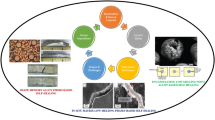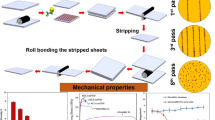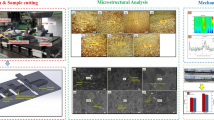Abstract
The current investigation fabricated the hybrid and single nanocomposite matrices via the friction stir process technique (FSP). AA1060 is used as the base matrix, and Al2O3 and BN nanoparticles were selected as reinforcement additives. The microstructure, hardness, wear, and electrical properties were evaluated and investigated experimentally. The microstructure observation showed excellent grain refinement during FSP due to dynamic recrystallization action. Furthermore, homogeneous and good dispersion of the reinforcement nanoparticles on the composite surface. The electrical conductivity of the hybrid surface composite was noticed to have the lowest value compared to the other single composite additive and base matrix. The addition of BN and Al2O3 nanoparticles separately increases the composite matrix hardness (45–55%) compared to the base aluminum alloy. It has also been noted that the addition of BN and Al2O3 nanoparticles separately increases the composite matrix, but the hybridization of the two reinforcement results in better improvement. The BN nanoparticles significantly affected the physical and wear behavior of the hybrid and mono-composite of such reinforcement nanoparticles. Hence, all nanocomposites reinforced with BN nanoparticlesachieved lightweight and better wear resistance.










Similar content being viewed by others
Data availability
The datasets supporting the conclusions of this work are included within the article and its additional files.
References
A. Kurt, I. Uygur, E. Cete, Surface modification of aluminium by friction stir processing. J. Mater. Process. Technol. 211(3), 313–317 (2011)
R.S. Mishra, Z.Y. Ma, I. Charit, Friction stir processing: a novel technique for fabrication of surface composite. Mater. Sci. Eng., A 341(1), 307–310 (2003)
S.J. James et al., Comparative study of composites reinforced With SiC and TiB2. Procedia Eng. 97, 1012–1017 (2014)
V. Sharma, U. Prakash, B.V.M. Kumar, Surface composites by friction stir processing: a review. J. Mater. Process. Technol. 224, 117–134 (2015)
E. Altin et al., Thermoelectric and mechanical properties of Mg–Al–Sb alloys. J. Mater. Sci. Mater. Electron. 26(2), 1023–1032 (2015)
V.M. Tchubarov, Z.A.A., G.A. Krivov, Metal matrix composite fabrication methods. in Fridlyander Metal matrix composites. soviet advanced composites technology series ed. by J.N. Fridlyander, vol 3 (1995), pp. 61–195
E.B. Moustafa, M.A. Taha, Preparation of high strength graphene reinforced Cu-based nanocomposites via mechanical alloying method: microstructural, mechanical and electrical properties. Appl. Phys. A 126(3), 220 (2020)
W.S. AbuShanab et al., Effect of graphene nanoparticles on the physical and mechanical properties of the Al2024-graphene nanocomposites fabricated by powder metallurgy. Results Phys. 19, 103343 (2020)
S. Biyik, Effect of cubic and hexagonal boron nitride additions on the synthesis of Ag–SnO2 electrical contact material. J. Nanoelectron. Optoelectron. 14(7), 1010–1015 (2019)
S. Biyik, Effect of reinforcement ratio on physical and mechanical properties of Cu-W composites synthesized by ball milling. Mater. Focus 7(4), 535–541 (2018)
S. Biyik, Influence of type of process control agent on the synthesis of Ag8ZnO composite powder. Acta Phys. Pol., A 135(4), 778–781 (2019)
S.S. Mirjavadi et al., Effect of multi-pass friction stir processing on the microstructure, mechanical and wear properties of AA5083/ZrO2 nanocomposites. J. Alloy. Compd. 726, 1262–1273 (2017)
J. Tang, Y. Shen, J. Li, Influences of friction stir processing parameters on microstructure and mechanical properties of SiC/Al composites fabricated by multi-pin tool. J. Manuf. Process. 38, 279–289 (2019)
N. Yuvaraj, S. Aravindan, Fabrication of Al5083/B4C surface composite by friction stir processing and its tribological characterization. J. Mater. Res. Technol. 4(4), 398–410 (2015)
E.B. Moustafa, S.M.S. Abdel-Wanis, T. Mahmoud, E.S. El-Kady, Review multi pass friction stir processing. Am. Sci. Res. J. Eng. Technol. Sci. (ASRJETS) 22(1), 98–108 (2016)
E.B. Moustafa, S.M.S.T.E.S. Abdel-WanisMahmoudEl-Kady, Characterization of elastic modulus for AA2024Al2O3 nanocomposite beam obtained from dynamic and static methods. Int. J. Res. Dev. Technol. 6(11), 124–128 (2016)
A. Baradeswaran, A.E. Perumal, Study on mechanical and wear properties of Al 7075/Al2O3/graphite hybrid composites. Compos. Part B: Eng. 56, 464–471 (2014)
H. Eskandari, R. Taheri, A novel technique for development of aluminum alloy matrix/TiB2/al2o3 hybrid surface nanocomposite by friction stir processing. Procedia Mater. Sci. 11, 503–508 (2015)
F. Karpasand, A. Abbasi, M. Ardestani, Effect of amount of TiB2 and B4C particles on tribological behavior of Al7075/B4C/TiB2 mono and hybrid surface composites produced by friction stir processing. Surf. Coat. Technol. 390, 125680 (2020)
A. Mazahery, M. Ostadshabani, Investigation on mechanical properties of nano-Al2O3-reinforced aluminum matrix composites. J. Compos. Mater. 45(24), 2579–2586 (2011)
E.B. Moustafa, A. Melaibari, M. Basha, Wear and microhardness behaviors of AA7075/SiC-BN hybrid nanocomposite surfaces fabricated by friction stir processing. Ceram. Int. 46(10), 16938–16943 (2020)
E.B. Moustafa, A.O. Mosleh, Effect of (Ti–B) modifier elements and FSP on 5052 aluminum alloy. J. Alloys Compd. 823, 153745 (2020)
F. Ostovan et al., Fabrication of Al5083 surface hybrid nanocomposite reinforced by CNTs and Al2O3 nanoparticles using friction stir processing. J. Compos. Mater. 54(8), 1107–1117 (2019)
H.G. Rana, V.J. Badheka, A. Kumar, Fabrication of Al7075/B4C surface composite by novel friction stir processing (FSP) and investigation on wear properties. Procedia Technol. 23, 519–528 (2016)
K. Umanath et al., dry sliding wear behaviour of AA6061-T6 reinforced SiC and Al2O3 particulate hybrid composites. Procedia Eng. 97, 694–702 (2014)
H.A. Al-Salihi, A.A. Mahmood, H.J. Alalkawi, Mechanical and wear behavior of AA7075 aluminum matrix composites reinforced by Al2O3nanoparticles. Nanocomposites 5(3), 67–73 (2019)
S. Kheirkhah et al., Microstructure, mechanical properties and corrosion resistance of Al6061/BN surface composite prepared by friction stir processing. Surf. Topogr.: Metrol. Prop. 7(3), 5002 (2019)
E.B. Moustafa et al., Microstructural, mechanical and thermal properties evaluation of AA6061/Al2O3-BN hybrid and mono nanocomposite surface. J. Market. Res. 9(6), 15486–15495 (2020)
W.S. AbuShanab, E.B. Moustafa, Effects of friction stir processing parameters on the wear resistance and mechanical properties of fabricated metal matrix nanocomposites (MMNCs) surface. J. Market. Res. 9(4), 7460–7471 (2020)
T. Dieguez, A. Burgueño, H. Svoboda, Superplasticity of a Friction Stir Processed 7075–T651 Aluminum Alloy. Procedia Materials Science 1, 110–117 (2012)
E. Moustafa, Effect of multi-pass friction stir processing on mechanical properties for AA2024/Al(2)O(3) nanocomposites. Materials 10(9), 1053 (2017)
E.B. Moustafa, S.M.S. Abdel-Wanis, T. Mahmoud, Surface composite defects of Al/Al2O3 metal matrix fabricated by Friction stir processing. J. Mater. Sci. Surf. Eng. 5(2), 524–527 (2017)
W.S. AbuShanab, E.B. Moustafa, Detection of friction stir welding defects of AA1060 aluminum alloy using specific damping capacity. Materials (Basel) 11(12), 2437 (2018)
E.B. Moustafa, Dynamic characteristics study for surface composite of AMMNCs matrix fabricated by friction stir process. Materials (Basel) 11(7), 1240 (2018)
N. Pol et al., Fabrication of AA7005/TiB2-B4C surface composite by friction stir processing: evaluation of ballistic behaviour. Def. Technol. 15(3), 363–368 (2019)
P. Rasagopal et al., A study surface integrity of aluminum hybrid composites during milling operation. J. Market. Res. 9(3), 4884–4893 (2020)
C.M. Rejil et al., Microstructure and sliding wear behavior of AA6360/(TiC+B4C) hybrid surface composite layer synthesized by friction stir processing on aluminum substrate. Mater. Sci. Eng., A 552, 336–344 (2012)
E.A.M. Shalaby et al., Preparation and characterization of hybrid A359/(SiC+Si3N4) composites synthesized by stir/squeeze casting techniques. Mater. Sci. Eng., A 674, 18–24 (2016)
S.A. Hosseini et al., Fabrication of Al5083 surface composites reinforced by CNTs and cerium oxide nano particles via friction stir processing. J. Alloy. Compd. 622, 725–733 (2015)
N. Takata, S.-H. Lee, N. Tsuji, Ultrafine grained copper alloy sheets having both high strength and high electric conductivity. Mater. Lett. 63(21), 1757–1760 (2009)
R.B. Naik et al., Development of high strength and high electrical conductivity Cu/Gr composites through friction stir processing. Mater. Lett. 265, 12743 (2020)
E.B. Moustafa, M.A. Taha, Preparation of high strength graphene reinforced Cu-based nanocomposites via mechanical alloying method: microstructural, mechanical and electrical properties. Appl. Phys. A (2020). https://doi.org/10.1007/s00339-020-3412-0
Ö. Güler et al., Effect of carbon nanotubes/graphene nanoplates hybrid to ZnO matrix: production, electrical and optical properties of nanocomposite. J. Mater. Sci.: Mater. Electron. 31(4), 3184–3196 (2020)
S. Mahboob, G. Prasad, G.S. Kumar, Impedance and a.c. conductivity studies on Ba(Nd0.2Ti0.6Nb0.2)O3 ceramic prepared through conventional and microwave sintering route. Bull. Mater. Sci. 29(4), 347–355 (2006)
M.A. Taha, M.F. Zawrah, Effect of nano ZrO2 on strengthening and electrical properties of Cu-matrix nanocomposits prepared by mechanical alloying. Ceram. Int. 43(15), 12698–12704 (2017)
M.F. Zawrah, H.A. Mostafa, M.A. Taha, Effect of SiC content on microstructure, mechanical and electrical properties of sintered Al-20Si-xSiC nanocomposites fabricated by mechanical alloying. Mater. Res. Exp. 6(12), 125014 (2019)
Acknowledgements
This project was funded by the Deanship of Scientific Research (DSR) at King Abdulaziz University, Jeddah, under grant No. (G: 54-135-1442). The author, therefore, acknowledges with thanks DSR for technical and financial support.
Author information
Authors and Affiliations
Corresponding author
Additional information
Publisher's Note
Springer Nature remains neutral with regard to jurisdictional claims in published maps and institutional affiliations.
Rights and permissions
About this article
Cite this article
Moustafa, E.B. Hybridization effect of BN and Al2O3 nanoparticles on the physical, wear, and electrical properties of aluminum AA1060 nanocomposites. Appl. Phys. A 127, 724 (2021). https://doi.org/10.1007/s00339-021-04871-5
Received:
Accepted:
Published:
DOI: https://doi.org/10.1007/s00339-021-04871-5




